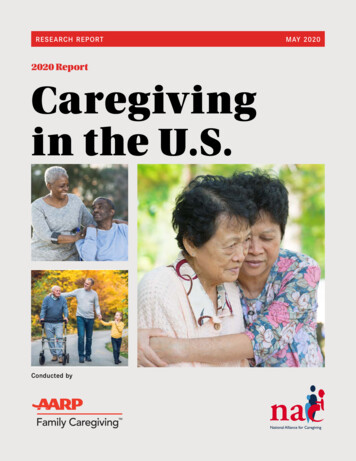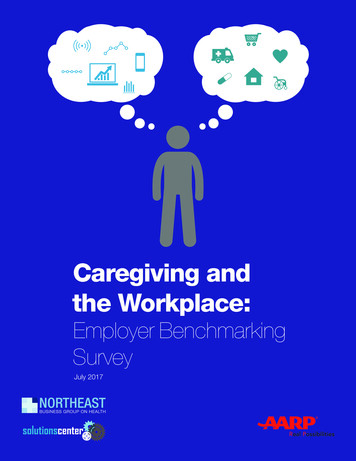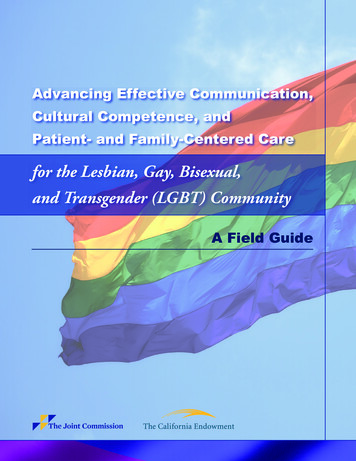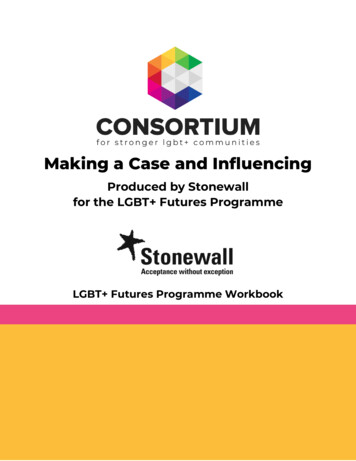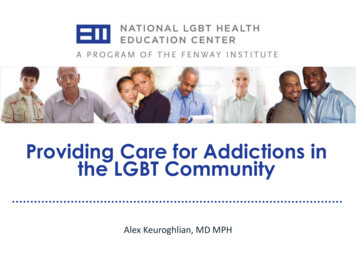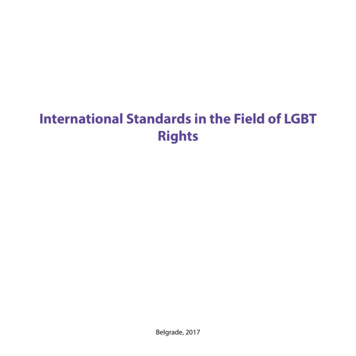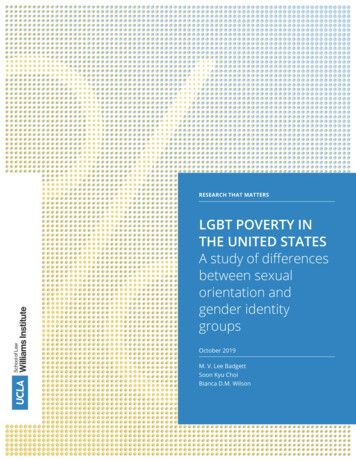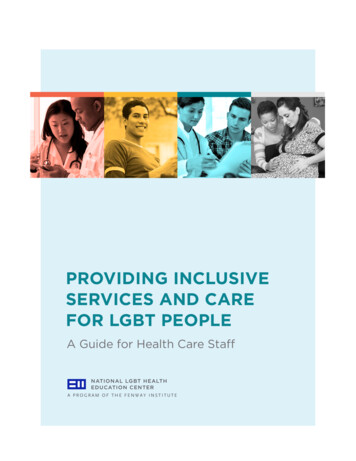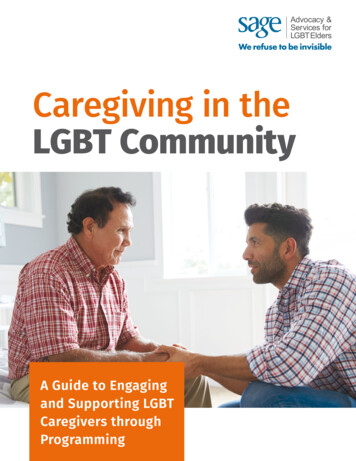
Transcription
Caregiving in theLGBT CommunityA Guide to Engagingand Supporting LGBTCaregivers throughProgramming
iiCaregiving in the LGBT CommunityContents01Introduction02 LGBT Older Adults03 Caregiving04 Caregiving in the LGBT Community05 LGBT Caregivers in Context06 Families of Choice06 Three Types of Caregivers09 Common Issues Facing LGBT Caregivers09 Legal Recognition of Families of Choice1011111213Likelihood to Access ServicesFinancial ConcernsCaregiver Burnout and IsolationSpecial Topic: Advance DirectivesCreating and Sustaining LGBT Caregiving Services141421Before you BeginSupportive ServicesEducational Programming24 Socialization and Wellness29 When Caregiving Ends30 Measuring Success31Conclusion33Additional ResourcesWritten by Daniel B. Stewart, MSG and Alex Kent, MPAReviewers: Lauren Averella, Megan Haag-Fisk, Tim R. Johnston, Hilary Meyer, Teresa Theophano, and Sherrill WaylandThe production of this guide was generously supported by the Harry and Jeanette Weinberg Foundation. SAGE, 2017, All rights reserved.
1SAGE · sageusa.orgIntroductionCaregiving is emerging as an increasingly important area of focusin the social services sphere, and service providers are seekingeffective ways to support the growing caregiving population.While all caregivers can benefit from supportive services, not allcaregivers are the same. Those who belong to the lesbian, gay,bisexual and transgender (LGBT) community have much in commonwith other caregivers, but also have unique experiences and needs.Successfully supporting LGBT caregivers requires an understandingof these differences as well as modified interventions designedto meet their needs. This guide will provide an overview of whatcaregiving looks like in the LGBT community, and offer serviceproviders ideas and best practices for reaching and supportingthese caregivers.
2Caregiving in the LGBT CommunityLGBT Older AdultsLGBT older adults make up 2.7 million of the quickly growing aging populationin the United States.1 By 2030, that number is expected to more than double.As social service providers prepare for the oncoming wave of older adultsnationwide, it is critical that the unique needs of LGBT older adults and thepeople who care for them are taken into account and addressed.DID YOUKNOW?Thepopulationof LGBTolderadults inthe U.S. isexpectedto doubleby 2030.Many LGBT older adults have experienced a lifetime of discrimination andsocial stigma, as well as institutionalized discrimination in health care,employment, and social services. Because of this history, LGBT older adultsas a group experience social, financial, physical and mental health disparities,and are at higher risk for developing chronic diseases, being diagnosed withdepression and anxiety, living in poverty, and experiencing social isolation.2,3While the provision of social services and quality medical care can help toalleviate some of these challenges, research shows that older LGBT adults aresignificantly less likely to access medical and social services than their nonLGBT peers.4 This can lead to a delay in care, premature institutionalization,and even premature death. 5.6Though the statistics seem troubling, the older LGBT population is in fact avibrant and resilient community, who have persevered by coming together andcaring for their own. An example of this resilience can be found in the waysin which the LGBT community came together during the HIV/AIDS crisis in the1980s. It was LGBT people who stepped up to provide caregiving support forlovers, friends and even strangers who were living with HIV/AIDS. As a result,social networks were expanded and strengthened, and survivors of that timehave continued to rely on these care networks.This guide is intended to help you activate that typeof resiliency as you seek to support LGBT older adultsand LGBT caregivers.We realize that LGBT familycaregivers face unique challenges,Robert StephenVice President,Health Security Programming,AARP, Washington, D.C.particularly as they see their friends andcommunity as family. We are working closelywith SAGE to support those caregivers acrossthe country as they care for their loved ones.With SAGE’s recognition, energy, and experience,together we will make this work a success.”
3SAGE · sageusa.orgCaregivingDID YOUKNOW?Unpaidcaregivingaccountsfor over85% ofelder carein the U.S.Caregiving is the act of providing physical, psychological, and/or emotionalassistance to another person, typically for an extended period of time. Aspeople age, their needs may become greater and their abilities may start todecline. In the event of a serious health problem, the onset of dementia, orother debilitating circumstances, care may be needed as much as 24 hours aday to keep the older adult safe.Though long-term care facilities may be an option, most people prefer to agein place, meaning they want to remain in their homes and communities foras long as they can. In most cases, this is made possible by the assistance ofcaregivers—unpaid family members and others who can provide the assistanceneeded for the older adult to maintain a good quality of life.According to Caregiving in the U.S., a 2015 study by AARP and The NationalAlliance for Caregiving, there are 34.2 million Americans who provide unpaidcare to another adult who is over the age of 50. The care they provide is aA note on terminology: The term “caregiver” is sometimesused to refer to professional care providers, such as homehealth aides or nurses, but in this guide we use the termTERMS“caregiver” to refer specifically to those caring for their friendsand loved ones.Caregiving is usually not something that ison our bucket list of things that we want todo; caregiving just happens!Christopher MacLellan, M.A.“The Bow Tie Guy”Author: “What’s The Dealwith Caregiving?”Certified CaregivingCoordinator & EducatorWholeCareNetwork.comLake Worth, FLSuddenly, there is an untimely diagnosis, or anunfortunate accident, and within a moment’snotice, two or more lives are forever changed andyou are a family caregiver. Caregiving can be anintense experience which will ask you to surrenderyourself and your own needs for the needs ofsomeone else. As a caregiver, you often give upthings you love to care for the one you love. That iswhy there are no gender or orientation boundarieswhen it comes to being a family caregiver, wesimply care for the one we love.”
4Caregiving in the LGBT Communitycritical part of the aging service provider network, as it accounts for over 85%of all elder care in the U.S. These unpaid hours of care for older adults arevalued at 522 billion annually.7DID YOUKNOW?1 in 5 LGBTpeople isproviding care,compared to1 in 6 nonLGBT people.Most people will experience caregiving as an important, meaningful,yet challenging role. It is very common for caregivers to feel stressed oroverwhelmed, especially as they try to balance caregiving with other aspectsof their lives, such as work or raising children. Many caregivers neglect theirown wellness while they are busy caring for another—skipping their owndoctor’s appointments, giving up time with friends, and decreasing theirexercise, sleep, or relaxation time. These lead to health disparities amongcaregivers, who experience increased rates of depression, anxiety, isolation,financial strain, poorer subjective health and increased mortality risk.8,9,10 Thestress associated with caregiving is often referred to as caregiver burden.Caregiver Burden: The stress associated with caregiving,including the physical, social, psychological, emotional, andfinancial strain that is associated with caring for someoneDEFINITIONover a long period of time. Signs may include depression,withdrawal, poor diet, exhaustion, and health problems.11Though there is a network of supportive services available for caregivers, manydo not know how to access those services or, very commonly, do not realizethat they are caregivers at all. Most caregivers will say that they are “just doingthe right thing,” “helping a friend,” or “being a good son,” without having anyidea that they belong to a large cohort of people who share similar feelingsand experiences. They may also reject the idea that they could use any supportor assistance themselves, though in fact we know that caregiver burden canhave a negative impact on both the caregiver and the person they’re caring for,and that proper support can help to alleviate that impact.Caregiving in the LGBT CommunityLGBT caregivers make up 9% of the 34.2 million Americans caring for adultsover age 50, which is an estimated 3 million people.12 LGBT people alsobecome caregivers at a slightly higher rate than their non-LGBT peers: 1 in 5LGBT people is providing care for another adult, compared to 1 in 6 non-LGBTpeople.13 LGBT caregivers come from a variety of different backgrounds andprovide care in a variety of different relationship structures, but there aresome common themes in the unique needs and experiences of most LGBTcaregivers, as well as those who are caring for LGBT older adults but may notbe LGBT-identified themselves. The next section will explore some of theseunique needs and relationships.
5SAGE · sageusa.orgLGBT Caregiversin ContextIn the general population, thevast majority of caregivers (85%)are caring for either a parent,spouse, or other relative.14Looking at that statistic inreverse, we see that when olderadults need care, they typicallyturn to a child, spouse, or otherrelative for assistance. LGBT olderadults are 4 times less likelyto have children and twice aslikely to be single as their nonLGBT peers.15 They may also beestranged from their biologicalor legal family members if thosepeople do not accept theirsexual orientation and/orgender identity.If an LGBT older adult has no legal family to rely on,who cares for them?I believe to be entrusted with the care ofanother human being is one of the greatesthonors bestowed on us.Yes, there will be difficult days, but there willbe days that are filled with the most beautifuland meaningful conversations two people willever have in life.”Christopher MacLellan, M.A.Author: “What’s The Deal with Caregiving?”Certified Caregiving Coordinator & EducatorWholeCareNetwork.comLake Worth, FL
6Caregiving in the LGBT CommunityFamilies of ChoiceBESTPRACTICEIncorporateFamiliesof Choiceinto alldiscussionsaboutcaregiving.In the absence of people to rely on from their families of origin, LGBTindividuals have a long history of creating Families of Choice, typically madeup of friends, partners, ex-partners, and perhaps a few relatives. As an LGBTperson ages they may turn to their family of choice to ensure their social,physical and emotional well-being. It is common for the majority of an LGBTolder adult’s close friends and chosen family to be older adults themselves,which means that many older LGBT individuals rely on one another forcaregiving, and a large number of LGBT older adults find themselvesbecoming caregivers.DEFINITIONBESTPRACTICEBe carefulwhen using theterm FamilyCaregiver. Ifyou mean toinclude friendsand otherunrelatedloved ones,be sure tostate that, orexplain thatyou mean“family” asdefined by thecare recipient.Families of Choice: Diverse family structures and support networksthat include but are not limited to life partners, close friends, andother loved ones not biologically related or legally recognized butwho are the source of social and caregiving support.LGBT people become caregivers at a higher rate than non-LGBT people, andmake up 9% of the caregivers in the United States.16 Yet a large number of LGBTcaregivers continue to go “under the radar” of aging service providers. This ispartially due to a lack of understanding about what “LGBT caregiving” is andwho the people in this category typically are.Three Types of CaregiversWhen we talk about “LGBT caregiving,” we are referring to three primarygroups, each of which has its own unique challenges and experiences:1. LGBT Older Adults Caring for Other LGBT Older AdultsExamples: A gay man caring for his husband; a bisexual woman caringfor her ex-partnerThe peer networks where LGBT older adults find care stem from families ofchoice, and provide critical support in times of need, often in the absenceof biological family. These caregivers generally do not see themselves ascaregivers; they simply see themselves as “doing the right thing” for a closefriend or partner. This is typical of all caregivers, but may be exacerbatedin the LGBT community because of non-traditional family structures.The term Family Caregiver may be particularly alienating to this group,both because they are not accustomed to their families of choice beingrecognized as “families,” and because so many have strained relationshipswith their families of origin.When the caregiver and the care recipient are both older adults, thecaregiver may experience diminished capacity to provide some types ofassistance. That can be problematic, especially if there are few others to
7SAGE · sageusa.orgstep in. For example, if the primary caregiver is hospitalized, what happensto the care recipient? Additionally, older LGBT people frequently adhereto a cultural norm of “taking care of our own,” and may be particularlyreluctant to reach out to service providers or to accept outside help whenit is offered.LGBT older adults are more likely to be caring for one another in isolation,without other people involved to share the burden. Only about half of allcaregivers have another unpaid caregiver to help them,17 and about 2/3 offamily of choice caregivers, many of whom identify as LGBT, provide solecare (43%) or are the primary caregiver (25%).18 Having just one caregivermeans that the person receiving care lacks a safety net, and that thecaregiver is likely to experience increased burden, both of which couldultimately jeopardize the care recipient’s ability to age in place.2. Caregivers Who Happen to Identify as LGBTExample: A lesbian daughter caring for her aging motherWhen a group of siblings need to provide care for an aging parent, it iscommon for the LGBT member of the group to become a primary caregiver.This may be because families of origin perceive their LGBT relatives to havemore time and availability—especially if they do not have children or arenot open to their families about their relationships and families of choice.19These caregivers are primarily young or middle-aged adults caring fortheir aging parents. Resources and services intended for general ornon-LGBT audiences will likely be more relevant to this group, becausethe relationship between the caregiver and a parent is a common onerecognized by many service providers. There are, however, some specificissues that arise for these caregivers.LGBT caregivers may seek out LGBT affirming services or facilities for theirloved ones, so that they will feel welcomed and respected themselves.However, depending on the attitudes of their care recipient, they maybe reluctant to talk about their identities or even involve a partnerin providing care. Also noteworthy is that these LGBT caregivers maybe providing care to a family member with whom there is a strainedMultiple Caregiving ExperiencesMany LGBT older adults fall into multiple categories of caregiving atthe same time. With LGBT individuals more likely to provide care tonon-relatives and their family members seeing them as more availableto provide care, LGBT individuals may be going through multiple caregivingexperiences and therefore have increased caregiving-related stress.(Fredriksen-Goldsen et al., 2011)
8Caregiving in the LGBT CommunityDID YOUKNOW?40% of LGBTolder adultsage 45-75 saythat theirsupportnetworkshave becomesmallerover time,compared to27% of nonLGBT olderpeople.SOURCE: OUT &VISIBLE, 2014relationship—it is not uncommon to hear of an LGBT individual caring foran ill parent who never accepted his or her identity. These caregivers mayrequire some additional emotional support to cope with caregiver burden.3. Others Caring for LGBT Older AdultsExamples: A nephew caring for his transgender aunt; a neighbor concernedabout the isolated gay man next door.Lastly, non-LGBT people caring for LGBT older adults may personally feelwelcomed in a wide variety of organizations and have other supportiveresources for their own wellbeing. However, when seeking resources fortheir care recipient they may be surprised to find limited LGBT-specificor openly affirming services. Because LGBT older adults are often quiteisolated, an observant neighbor, acquaintance or distant relative may bethe one who calls an aging service provider to seek help for that person.If they know the individual is LGBT, they may seek assistance locatingan LGBT program or help from the local LGBT community. It should benoted that these non-LGBT caregivers provide access to some of the mostisolated members of the LGBT aging community.IN CONCLUSION: The most vulnerable of these groups is LGBT older adultscaring for their LGBT peers. These caregivers experience compounded healthdisparities, and many have the added stress of knowing that there is no oneelse to care for their loved one should they need to relinquish their caregivingduties. They may be reluctant to access services for either themselves or theirloved ones, and require particular attention to engage and support.As we look at the caregiving relationships within the LGBT community, we seesimilarities and differences among several different kinds of caregivers. It isour hope that this guide will help you to support all of these populations byproviding information and tools to assist you in creating programs that areresponsive to the common needs of caregivers in the LGBT community.SAGE LGBT Elder HotlineThere are some LGBT older adults who areso isolated they truly have no one who canserve as a caregiver. Connecting them withresources and organizations that are LGBTaffirming is critical. One resource for theseolder adults is the SAGE LGBT Elder Hotline:1-888-234-SAGE. This toll-free numberconnects older LGBT people to a trainedvolunteer who can provide resources andpeer-to-peer support.
SAGE · sageusa.orgCommon IssuesFacing LGBT CaregiversLegal Recognition ofFamilies of ChoiceFor many LGBT people, familiesof choice are the cornerstones ofcaregiving. These chosen familiesprovide social, emotional andphysical support, and often serve asadvocates when medical needs arise.However, most families of choice arenot afforded any legal recognitionor protection, and service providersmay not think to inquire aboutor include these people in theirwork. It is important to recognizethese relationships, and to providesupport in completing paperworkthat ensures the wishes of the carerecipient are recognized.The CARE ActA majority of states have adopted some version of the CARE (CaregiverAdvice, Record, and Enable) Act. This legislation varies from state tostate, but its basic premise is that hospitals are required to ask patientsat admission whether they’d like to designate a caregiver.Once a caregiver is named, regardless of that person’s relationship to the patient,the hospital is generally required to record the name of the caregiver in medicalrecords, inform the caregiver when the patient is being discharged, and give thecaregiver adequate training on how to perform any medical tasks needed at home.Importantly, most versions of the CARE Act have no stipulations about who may benamed as the caregiver, which means that the patient can name a friend or chosenfamily member and have the hospital formally recognize that person as the caregiver.Contact your local AARP office for more information about the CARE Act in your state.9
10Caregiving in the LGBT CommunityBESTPRACTICEHelp toensure thatALL olderadults haveadvancedirectives inplace.DID YOUKNOW?LGBT olderadults arefive timesless likely toseek medicalcare or socialservicesGuidelines released by the Obama administration in 2011 extended hospitalvisitation rights to individuals regardless of sexual orientation, genderidentity, or family makeup. However, in the absence of advance directives thatspecifically name the person(s) appointed by an individual to make medicaldecisions on their behalf, hospital personnel are obligated to rely on thepatient’s next of kin for any medical decisions. Assisting the care recipient withcompleting advance directives is essential to help ensure that their caregiverhas the right to make medical decisions during a time of medical crisis. You’llfind more information about advance directives at the end of this section.Likelihood to Access ServicesLGBT older adults are five times less likely to seek medical care or socialservices than the general public.20 This is understandable when consideringthat older LGBT individuals endured decades of stigma and even harassmentfrom providers. By avoiding medical care, they are often putting themselves atrisk for negative health and mental health outcomes. With this strong mistrustand skepticism towards providers, some LGBT caregivers and the LGBTindividuals they care for may choose to keep their identities secret, or simplynot engage in services unless they are certain that they will be welcomed.When they do reach out to providers, caregivers may be reluctant to share thenature of their relationship, either to protect their loved one from being outed,or for fear of being shunned or dismissed from their loved one’s care team.This lack of transparency may not only invalidate the identity of the caregiverbut has serious ramification in providing comprehensive care and services.In order to support LGBT older adults and caregivers, it is crucial for careproviders to anticipate non-traditional family structures and provide supportto them as they would caregivers who are traditional relatives.Our program had a client who was very hesitant to reveal her relationship to the womanshe was caring for. When she was finally asked directly, she shared that the woman washer ex. She had been afraid to reveal that because of the reactions she’d received inother settings where she tried to access services.One telephone operator at a local resource hotlineasked her rudely “Why areNate Sweeney, MA, LNHAyou caring for your ex?!”and encouraged her to be less involved. It was fromtheir former relationship that our client knew thiswoman did not have family supports. When someonesteps up, we have to support them for it.”Executive DirectorThe LGBT Health Resource Centerof Chase Brexton Health CareBaltimore, MD
11SAGE · sageusa.orgFinancial ConcernsLGBT older adults are less likely to be financially ready for life afterretirement.21 The financial barriers can make it difficult for an LGBT older adultto coordinate and afford additional support and resources, thus increasingtheir reliance on loved ones. When the care recipient has fewer resources,caregivers may feel pressure to help provide health care, food, and otheressentials for their loved one and, in turn, neglect themselves. Caregivers whoqualify for public benefits or other assistance themselves may not seek themout because they are too busy providing care.Caregiver Burnout and IsolationThe act of providing physical, emotional, and perhaps financial support toan ill or aging person can lead to isolation, stress, and eventually caregiverburnout. When a caregiver burns out it may result in their care recipientbeing temporarily neglected or being moved into long-term care prematurely.Caregiving in isolation, without others to share the burden, may increase therisk of burnout.Though caregivers often express the benefits of caregiving, such as forming aclose bond with the care recipient or a sense of satisfaction from giving back,One research study found that adult children of lesbian, gay, bisexual and transgenderelders faced discrimination as they advocated for the care and empathy of their lovedones. The findings showed that inequities exist in their ability to access health care fortheir loved ones and in the delivery of such services. Such discrimination was often basedon the perception of the elder being a gay male or lesbian woman (Brotman, Ryan, Collins, et al., 2007).One can imagine the hurt and hopelessness of the caregiver trying to advocate for quality andnecessary services for their LGBTQ loved one, and to find subtle and not so subtle indicators thatthey and the person they love are being treated in such a manner. Also, if the loved one is a samegender partner, how can the caregiver protect her/him/themselves and their mate? Must they passas siblings? Perhaps, as a safety plan in the face of staff that is prejudicial and untrained in basicLGBTQ/Same-Gender Loving (SGL) culture.Combined perceived or actual oppression ofhomophobia hurts the very people needingsocial services.I would go further and affirm that by virtue of thefrequent social isolation of LGBTQ/SGL people, LGBTQ/SGL elders will be less likely to access the very socialnetworks that are important factors to successful aging,like Caregiving Circles and Support Groups.”Dr. Imani WoodyPresident and CEO,Mary’s House for Older Adults, Inc.Washington, D.C.
12Caregiving in the LGBT Communitythey are also at high risk for emotional distress and poor health outcomes.The strain of putting another person’s needs first can be compounded byemployment and other time commitments outside of caregiving, by thecaregiver not being out in their social or work life, or by a conflict in therelationship (as in the case of an LGBT child caregiving for an unsupportiveparent). All caregivers are susceptible to caregiver burnout; the LGBT caregiveris likely to experience some additional factors that can increase caregiverburden and lead them to burn out more quickly.Whether an LGBT caregiver is providing care for a member of their familyof origin or family of choice, it is apparent that this population is in needof supportive services. It is important to understand the complexitiesand challenges LGBT individuals face, as well as the unique issues of LGBTcaregiving in light of what is known about caregivers in general. By reachinga point of understanding, organizations can begin to develop meaningful andapproachable direct services and support for LGBT caregivers.Special Topic: Advance DirectivesAdvance directives allow an individual to ensure that their wishes will behonored should they become unable to communicate or make decisions forthemselves. All adults should have advance directives in place, but they areparticularly important for people whose caregivers or closest loved ones are not legalrelatives, as is the case for many LGBT people.Anyone whose primary caregiver is not their legal next of kin should consider puttingtogether the following documents to ensure their wishes are respected (adapted fromLambda Legal’s Take the Power toolkit): Medical Power of Attorney (sometimes called a Health Care Proxy) Living Will Hospital Visitation Directive HIPAA Waiver Financial Power of Attorney Will Written documentation of an individual’s wishes upon their death—may includefuneral arrangements, disposition of remains, organ/tissue donation, pre-writtenobituary, etc.State-specific advance directive forms and instructions can be obtained from your statehealth department or local Area Agency on Aging, or at the following websites: AARP: aarp.org/advancedirectives National Hospice and Palliative Care Organization: caringinfo.org/advancedirectives National Healthcare Decisions Day: nhdd.org/state-specific-resources
13SAGE · sageusa.orgCreating and SustainingLGBT Caregiving ServicesSupporting LGBT caregivers through programsand services is one of the best ways for anagency or organization to have a positiveimpact on the lives of both caregivers and olderadults receiving care. This section includesa number of programs that have been foundto be helpful for caregivers, along with notesabout things to keep in mind regarding LGBTcaregivers specifically.Service providers are encouraged to pick andchoose among the programs suggested here, inorder to best match the capacity of your agencyto the needs of the local service population.It is not necessary to start from scratch increating programs for LGBT caregivers; in fact,you may be more successful if you work tobuild on existing programs. Assess what yourorganization already does well, and look forLGBT caregivers’ needs are unique since oftenthey are not biological family members and are not treated with the same respector understanding. Many of the LGBT caregivers in our program are LGBT older adultsthemselves. Both caregivers and care recipients benefit from our programming—from support groupsfor caregivers to Friendly Visitors for homebound care recipients, and case management to addressconcrete needs for both, SAGE ensures that a holistic care plan is enacted. Challenges can emergewhen care recipients refuse help from anyone except a caregiver, which puts tremendous strainon that caregiver. And sometimes caregivers arereluctant to accept help themselves, prioritizing careTeresa Theophanorecipients’ needs over their own. Further, sometimesAssistant Directorfriends and members of chosen family involvedCare Management Servicesin a loved one’s care don’t think of themselves asSAGEcaregivers and so may not want to attend a supportNew York, NYgroup or accept other assistance.”
14Caregiving in the LGBT Communityopportunities to expand your programming to include this particular audience.That may mean adding a caregiver support group at your LGBT center, or makingsure that your case managers know which external resources will be welcomingto your LGBT clients. Whatever path you choose, know that a little effort can goa long way toward improving the lives of LGBT older adults and caregivers.On the following pages we provide suggestions in the areas of supportiveservices, educational programming, socialization & wellness, and griefcounseling.Before You BeginBESTPRACTICEEnsure thatyour agencyis welcomingto LGBT olderadu
in which the LGBT community came together during the HIV/AIDS crisis in the 1980s. It was LGBT people who stepped up to provide caregiving support for lovers, friends and even strangers who were living with HIV/AIDS. As a result, social networks were expanded and strengthened, and survivors of that time have continued to rely on these care .


